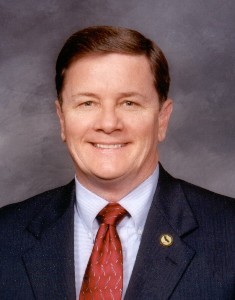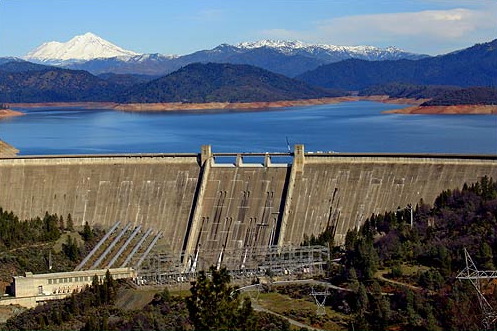As the falling rain pings against my window here in North California, I am relieved that it will alleviate some of the shortage of stored water predicted for this upcoming usage season in California. Dramatic reductions in water delivery, especially to Central Valley agriculture are very likely. Those in the cattle business are lamenting what has been the shortest rainfall during this area’s winter months, [January being one of the driest on record in California] for as long as they can remember, with grazing lands short of foliage and already starting to turn to the summer brown. These rains in recent days can only help.
What else would help is some real action by humans on providing for their own water needs. Relying on rain dances, good luck, or if you’re the 1948 Boston Braves with only 2 reliable pitchers for a 7 game World Series, "Spahn and Sain and pray for rain", we can ask for Divine intervention every rain year and do nothing with our God-given abilities to help ourselves.
Governor Schwarzenegger has made a firm commitment to building above ground water storage in this state, something we used to do, and do well. Of course many Californians now enjoy and rely on in their day-to-day lives water from that vision and forethought that produced our state and federal water projects.
 The continuation of the what was attempted in the 2006 Infrastructure Bonds, more surface water storage, but fell out of the negotiations, can be realized with a bill by Senator Dave Cogdill, The Reliable Water Supply Bond Act of 2008. This bill is currently known as SB 59, with several bi-partisan co-authors, plus the support of the Guv. Several other bonds have passed over the last 15 years that address "safe water", "drinking water" etc. but all have merely nibbled, if anything, at expanding water supply. Agency projections estimate that we are short 4-6 million acre feet of storage for the types of drought that can occur and the growth that this state will see by 2020. The last state effort of any size to add to storage was the New Melones Reservoir, completed in 1979.
The continuation of the what was attempted in the 2006 Infrastructure Bonds, more surface water storage, but fell out of the negotiations, can be realized with a bill by Senator Dave Cogdill, The Reliable Water Supply Bond Act of 2008. This bill is currently known as SB 59, with several bi-partisan co-authors, plus the support of the Guv. Several other bonds have passed over the last 15 years that address "safe water", "drinking water" etc. but all have merely nibbled, if anything, at expanding water supply. Agency projections estimate that we are short 4-6 million acre feet of storage for the types of drought that can occur and the growth that this state will see by 2020. The last state effort of any size to add to storage was the New Melones Reservoir, completed in 1979.
So you may grumble, "Great, another bond." I could agree except that a) this long term infrastructure is the kind of thing you use long term borrowing for, that pays for itself with true benefits to the public and the economy long term. b) we are so far behind in planning and building, with impending shortages of water just one drought away [like January] and ever increasing population growth, [not to mention the court decisions that keep shifting more and more existing water to fish needs that may or may not be real…ask any farmer, the shifts are real] that we are not going to catch this one up with a pure "pay as you go" on this type of infrastructure.
However, Senator Cogdill’s bill does acknowledge pay as you go with $2 billion of the total bond package being revenue bonds and that the bonds can’t be expended until 75% of the water produced by any proposed projects is committed to water buyers, a very good market approach in a trying circumstance. The total package includes $3.95 Billion of G.O. bonds, of which $1B will address the Delta and it’s need for long term sustainablity as a water conveyance system and the bulk towards a proposed Sites Reservoir in western Colusa county and Temperance Flat Reservoir north east of Fresno, both of which would produce a combined 3.1 million acre feet. [An average family use is about 1/2 acre foot]
 Building dams is not a quick process. The numbers for water use projected by 2020 are ominous, and it will probably take that long to get projects done. So, whether it is Sites or Temperance Flat, the 2 front running proposals, a Los Vaqueros or Shasta Dam expansion, or others, there is no time to waste. While the global warming argument has more holes in it than the Dutch dike the little boy plugged, there could be a naturally occuring cyclical climate change that causes early snow [snow as a de facto dam] melt and water runoff to the ocean. We have water "everywhere" now that we are not capturing. If this climate change is indeed occuring, this even more exacerbates the need to take action on water storage…for water supply, for flood control, for hydroelectric generation…all things California needs and government has neglected for decades.
Building dams is not a quick process. The numbers for water use projected by 2020 are ominous, and it will probably take that long to get projects done. So, whether it is Sites or Temperance Flat, the 2 front running proposals, a Los Vaqueros or Shasta Dam expansion, or others, there is no time to waste. While the global warming argument has more holes in it than the Dutch dike the little boy plugged, there could be a naturally occuring cyclical climate change that causes early snow [snow as a de facto dam] melt and water runoff to the ocean. We have water "everywhere" now that we are not capturing. If this climate change is indeed occuring, this even more exacerbates the need to take action on water storage…for water supply, for flood control, for hydroelectric generation…all things California needs and government has neglected for decades.
The extreme wing of the enviro movement must acknowledge a solution instead of road blocking surface storage as part of a comprehensive solution including conservation and desalination. A popular bumper sticker around here is "When you gripe about the farmer, don’t talk with your mouth full" Maybe those that oppose surface storage need to see one reading something like, "When you gripe about dams, don’t gargle"

